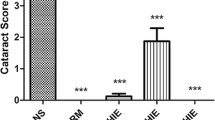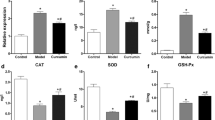Summary
This study investigated the inhibitory effect of grape seed proanthocyanidin extract (GSPE) on selenite-induced cataract formation in rats and the possible mechanism. Eighty 8-day-old Sprague-Dawley rats were divided randomly into 5 groups: control group, model group, three GSPE groups (low dose, medium dose and high dose). Control group received subcutaneous injection of physiological saline. Model group was given subcutaneous injection of sodium selenite (20 μmol/kg body weight) on the postpartum day 10, and once every other day for consecutive three times thereafter. GSPE treated groups were respectively administered GSPE at doses of 50, 100, and 200 mg/kg body weight intragastrically 2 days prior to the selenite injection (that was, on the postpartum day 8), and once daily for fourteen consecutive days thereafter. The opacity of lenses was observed, graded and photographed under the slit lamp microscopy and the maximal diameter of the nuclear cataract plaques was measured. The lenses were analyzed for superoxide dismutase (SOD), catalase (CAT), glutathione peroxidase (GSH-PX), malondialdehyde (MDA), calcium (Ca2+), nitric oxide (NO) and anti-hydroxyl radical ability (anti-OH−). The histomorphology of lenses was observed with HE staining under a light microscope. The levels of calpainII, and iNOS protein and mRNA expression in lenses were detected by using immunohistochemistry and real-time quantitative RT-PCR. The results showed subcutaneous injection of sodium selenite led to severe nuclear cataract in model group, and the achievement ratio of model group was 100%. As compared with model group, the degree of lenses opacity and the maximal diameter of nuclear cataract plaques were significantly reduced in GSPE-treated groups. Moreover, we observed selenite treatment caused a significant decrease in the activities of antioxidative enzymes (SOD, CAT, GSH-PX) and anti-OH− ability, accompanied by a significant increase in the levels of MDA, NO, Ca2+ as well as iNOS, and calpainII protein and mRNA expression. Administration of GSPE could dose-dependently preserve the activities of these antioxidative enzymes and anti-OH− ability, accompanied by a significant reduction in the levels of MDA, NO, Ca2+ as well as iNOS, and calpainII protein and mRNA expression. These results suggested that GSPE markedly prevented selenite-induced cataract formation probably by suppressing the generation of lipid peroxidation and free radicals as well as the activation of iNOS, and calpainII in the lenses.
Similar content being viewed by others
References
Thylefors B. Avoidable blindness. Bull World Health Organ, 1999,77(6):453
Thylefors B. Global data on blindness. Bull World Health Organ, 1995,73(1):115–121
Olson RJ, Mamalis N, Werner L, et al. Cataract treatment in the beginning of the 21st century. Am J Ophthalmol, 2003,136(1):146–154
Truscott RJ. Age related nuclear cataract-oxidation is the key. Exp Eye Res, 2005,80(2):709–725
Sakthivel M, Elanchezhian R, Ramesh E, et al. Prevention of selenite-induced cataractogenesis in Wistar rats by the polyphenol, ellagic acid. Exp Eye Res, 2008,86(2): 251–259
Thomas R, Hong Ma, Chiho Fukiage, et al. Selenite nuclear cataract: review of the model. Mol Vis, 1997,3:8
Bagchi D, Garg A, Krohn RL, et al. Protective effects of grape seedproanthocyanidins and selected antioxidants against TPA-induced hepatic and brain lipid peroxidation and DNA fragmentation, and peritoneal macrophage activation in mice. Gen Pharmacol, 1998,30(5):771–776
Bagchi D, Garg A, Krohn RL, et al. Oxygen free radical scavenging abilities of vitamins C and E, and a grape seed proanthocyanidin extract in vitro. Res Commun Mol Pathol Pharmacol, 1997,95(2):179–189
Debasis B, Manashi B, Sidney JS, et al. Free radicals and grape seed proanthocyanidin extract: importance in human health and disease prevention. Toxicology, 2000,148(2–3):187–197
Ito Y, Nabekura T, Takeda M, et al. Nitric oxide participates in cataract development in selenite-treated rats. Curr Eye Res, 2001,22(3):215–220
Biju PG, Rooban BN, Lija Y, et al. Drevogenin D prevents selenite-induced oxidative stress and calpain activation in cultured rat lens. Mol Vis, 2007, 13:1121–9
Manikandan R, Thiagarajan R, Beulaja S, et al. Anti-cataractogenic effect of curcumin and aminoguanidine against selenium-induced oxidative stress in the eye lens of Wistar rat pups: An in vitro study using isolated lens. Chem Biol Interact, 2009,181(2):202–209
Hiraoka T, Clark JI. Inhibition of lens opacification during the earlystages of cataract formation. Invest Ophthalmol Vis Sci, 1995,36(12):2550–2555
Livak KJ, Schmittgen TD. Analysis of relative gene expression data using real-time quantitative PCR and the 2(-Delta Delta C(T)) method. Methods, 2001,25(4): 402–408
Spector A. Oxidative stress induced cataract: mechanism of action. FASEB J, 1995,9(12):1173–1182
Henein M, Morris S, Varma SD, et al. Prevention of selenite cataract by vitamin C. Exp Eye Res, 1991,52(5): 563–568
Behndig A, Svensson B, Marklund SL, et al. Superoxide dismutase isoenzymes in the human eye. Invest Ophthalmol Vis Sci, 1998,39(3):471–475
Yang Y, Spector A, Ma W, et al. The effect of catalase amplification on immortal lens epithelial cell lines. Exp Eye Res, 1998,67(6):647–656
Manikandan R, Thiagarajan R, Beulaja S, et al. Effect of curcumin on selenite induced cataractogenesis in Wistar rat pups. Curr Eye Res, 2010,35(2):122–129
Wang D, Li Y, Hou G, et al. Pygeum africanum: effect on oxidative stress in early diabetes-induced bladder. Int Urol Nephrol, 2009,42(2):401–408
Biswas S, Harris F, Singh J, et al. Role of calpains in diabetes mellitus-induced cataractogenesis: a mini review, Mol Cell Biochem, 2004,261(1–2):15l–159
Ahuja RP, Borchman D, Dean WL, et al. Effect of oxidation on Ca2+-ATPase activity and membrane lipids in lens epithelial microsomes. Free Radic Biol Med, 1999,27(1–2):177–185
Wang Z, Bunce GE, Hess JL. Selenite and Ca2+ homeostasis in the rat lens: effect on Ca2+-ATPase and passive Ca2+ transport. Curr Eye Res, 1993,12(3):213–218
Kemal O, Fatih K, Zeliha B. May nitric oxide molecule have a role in the pathogenesis of human cataract? Exp Eye Res, 2003,76(1):23–27
Beckman JS, Beckman TW, Chen J, et al. Apparent hydroxyl radical production by peroxynitrite: Implication for endothelial injury from nitric oxide and superoxide. Proc Natl Acad Sci USA, 1990,87(4):1620–1624
Author information
Authors and Affiliations
Corresponding author
Rights and permissions
About this article
Cite this article
Zhang, X., Hu, Y. Inhibitory effects of grape seed proanthocyanidin extract on selenite-induced cataract formation and possible mechanism. J. Huazhong Univ. Sci. Technol. [Med. Sci.] 32, 613–619 (2012). https://doi.org/10.1007/s11596-012-1006-6
Received:
Published:
Issue Date:
DOI: https://doi.org/10.1007/s11596-012-1006-6




